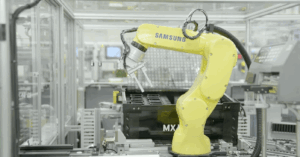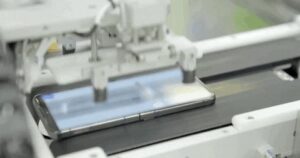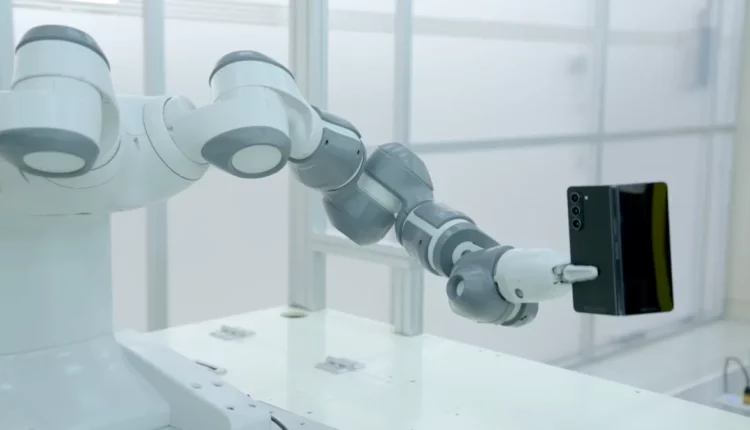©2021 Reporters Post24. All Rights Reserved.
At Samsung is mobile-device factory in Gumi, South Korea, roughly three hours away from the country’s capital of Seoul, nearly everything is automated. Even the process of putting on the shoe covers that are required to enter parts of the facility is handled by a machine(Robots).
The sound of bots whirring, air gaskets blowing and mechanical arms shifting positions can be heard throughout the facility. Every once in a while, an autonomous robot will play a cute jingle to signal its arrival. These robots, known as AGVs (for automated guided vehicles), roam the factory floor shuttling materials to their designated stations, guided by aluminum tracks on the floor. I’m told there are 80 of the bots in the company’s Gumi facility, where phones like the Galaxy S23 and the new Galaxy Z Flip 5 are assembled.
Roving robots and mechanical arms may be common within factories at this scale (just ask Amazon). And given that Samsung’s facility has produced 6 billion gadgets since 1988 and pumps out more than a million flagship phones per month, it’s no wonder the company has enlisted automated assistance. But visiting Samsung’s mobile factory, where I witnessed a Galaxy S23 Ultra go from little more than a circuit board to a fully packaged product, illustrates just how granular, regimented and of course automated the production process is.
A visit also provides some context around why it takes so long for new devices to go from concepts to commercially available products. In addition to ensuring technologies like foldable screens or rollable displays function properly, Samsung needs to develop new machines and integrate inspection processes into the production line to assemble them at scale. Every component, even the seemingly minor ones like a fingerprint sensor, has its own designated spot within the production line for quality checks.

But despite all this testing, Samsung has still been caught up in controversies regarding malfunctioning products. It infamously had to recall the Galaxy Note 7 in 2016 after overheating issues. And it delayed the launch of its first foldable phone, the Galaxy Fold, in 2019 after some reviewers reported broken screens. Search Reddit, and you’ll find stories of Galaxy Z Flip owners with faulty devices.
Before visiting the area where Galaxy phones are assembled, I learned about the surface mount device process. This is where materials are mounted and soldered onto a printed circuit board, which is essentially the cardiovascular system of your Galaxy phone. Materials are spooled out from what looks like a giant ribbon reel, with an average of 23 to 25 components being mounted every time you blink.
After the soldering process and various inspections, a large printed circuit board is then cut into the smaller individual boards that power phones. One board is typically divided into parts that can power four to six phones.

Though I didn’t get to view these steps, because the facility needs to be temperature, humidity and dust-controlled, I did get a front-row seat to the main production line. Robotic arms diligently moved partially assembled Galaxy S23 Ultras around the conveyor belt, meticulously fastening connectors and inserting screws.
A large portion of the assembly line is dedicated to quality checks. Samsung says there are about 30,000 to 50,000 inspection items for the Galaxy S23 lineup alone. That includes the S Pen connection; the charging port; near-field communication functionality (or NFC, the tech that powers contactless payments); touch screen panels; fingerprint sensors; cameras; speakers; the SIM card tray; and Wi-Fi connections. There are also checkpoints within the assembly line for chips that enable millimeter wave 5G connections and ultra wideband, the proximity-sensing tech that enables phones to more easily share files and to function as digital car keys.
Robots are everywhere during the assembly process, but it isn’t all machinery on Samsung’s factory floor. Nearly a thousand employees work on this line alone. I was reminded of that once I left the factory floor and roamed the campus grounds, where employees were taking afternoon strolls beneath colorful umbrellas to shield them from the sun.
The assembly line is also just one part of Samsung’s facility. There’s also an automation lab on the company’s premises, where Samsung tests current and upcoming devices to see whether they perform as they should under normal use. (That differs from the reliability lab in Samsung’s Digital City campus in Suwon, South Korea, where devices are evaluated under more punishing and stressful conditions.)
And yes, just like the assembly line, it’s full of robots that methodically plug away at their assigned tasks. Samsung says six months of testing in this lab is equivalent to two years of consumer use.
It’s in this lab that Z Flips and Z Folds are folded and unfolded over and over again, S Pens are plugged in and out of phones continuously, and machines peck away at on-screen keyboards. Robotic arms rigorously wiggle and wave with Galaxy Watches on their wrists to simulate workouts.
A chamber within the lab houses five facial models for testing facial recognition, a common feature on most Samsung smartphones. Though I couldn’t see inside, I’m told there are different models meant to test how the technology works among various ethnicities and in multiple lighting conditions.
There’s a test for seemingly everything you could imagine, including simple tasks like walking with your phone in your hand and swaying it as you step. And these are only a fraction of the tests Samsung runs. In other corners of the lab, robots are charging and draining the batteries in Samsung’s phones, plugging in Galaxy Buds over and over again and testing fingerprint sensors under different temperatures.
After getting a look at Samsung’s testing lab and production line, I’m starting to understand why new gadgets take so long to go from prototype to product. Samsung was showing off flexible display technology back in 2011, long before the first Galaxy Fold arrived in 2019. That makes me wonder how long it’ll be before other devices that are in the concept stage graduate to real products.
At CES 2023, the annual tech convention that takes place in Las Vegas every January, Samsung showcased concept devices with slidable displays that can expand as needed. Samsung mobile chief T.M. Roh also told CNET in an interview that the company has other concepts in the works besides what’s been shown at CES.
Beyond phones, Samsung has also teased a mixed reality project that it’s creating in collaboration with Google and Qualcomm. And rumors have begun circulating about a health-tracking Samsung Galaxy ring.
Only time will tell where Samsung’s product roadmap goes next. But if the company is testing new bendable gadgets and smart rings, I’m sure they were being tested somewhere in Samsung’s labs, far out of sight.


